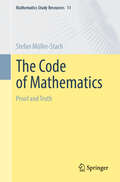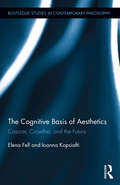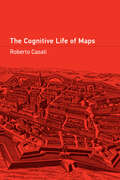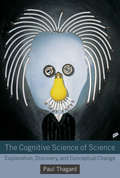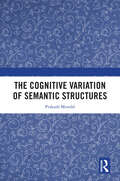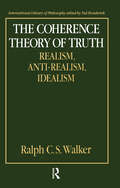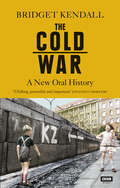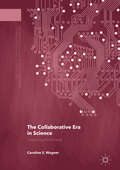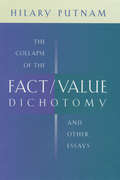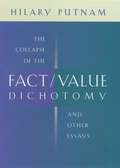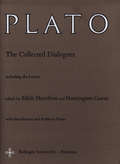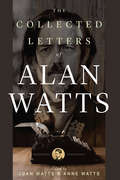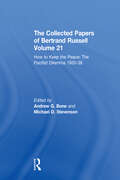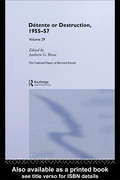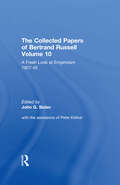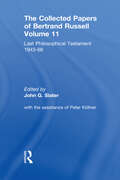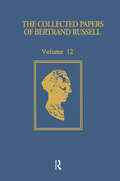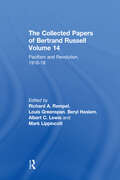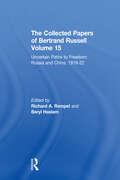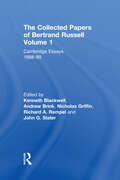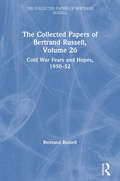- Table View
- List View
The Code of Mathematics: Proof and Truth (Mathematics Study Resources #11)
by Stefan Müller-StachInspired by recent developments in dependent type theory and infinity categories, this book presents a history of ideas around the topics of truth, proof, equality and equivalence. Besides selected ideas of Platon, Aristoteles, Leibniz, Kant, Frege and others, the results of Gödel and Tarski on incompleteness, undecidability and truth in deductive systems and their semantic models are covered. The main focus of this textbook is on dependent type theory and its recent variant homotopy type theory. Such theories contain identity types, which give a new understanding of equality, symmetry, equivalence and isomorphism in a conceptual way. The interaction of type theory and infinity category theory yields a new paradigm for a structural view on mathematics. This supports the tendencies towards formalising mathematics with the help of proof assistants. This book was first published in German. The translation was done with the help of artificial intelligence. A subsequent human revision was done primarily in terms of content.
The Cognitive Basis of Aesthetics: Cassirer, Crowther, and the Future (Routledge Studies in Contemporary Philosophy)
by Elena Fell Ioanna KopsiaftiThis book seeks to fill a void in contemporary aesthetics scholarship by considering the cognitive features that make the aesthetic and artistic worthy of philosophical study. Aesthetic cognition has been largely abandoned by analytical philosophy, which instead tends to focus its attention on the ‘non-exhibited’ properties of artwork or issues concerning semantic and syntactic structure. The Cognitive Basis of Aesthetics innovatively seeks to correct the marginalization of aesthetics in analytical philosophy by reinterpreting aesthetic cognition through an integration of Ernst Cassirer’s philosophy of symbolic forms with Paul Crowther’s theory of imagination and philosophy of art. This integration has three important outcomes: 1) it explains why the aesthetic and artistic constitute a unique form of knowledge; 2) it shows the role this plays in the formation of aesthetics as a discipline; and 3) it describes why aesthetic cognition is so deeply engaging. This book’s unique theoretical approach engages with important works of visual, conceptual, and digital art, as well as literature, music, and theatre.
The Cognitive Life of Maps
by Roberto CasatiThe &“mapness of maps&”—how maps live in interaction with their users, and what this tells us about what they are and how they work.In a sense, maps are temporarily alive for those who design, draw, and use them. They have, for the moment, a cognitive life. To grapple with what this means—to ask how maps can be alive, and what kind of life they have—is to explore the core question of what maps are. And this is what Roberto Casati does in The Cognitive Life of Maps, in the process assembling the conceptual tools for understanding why maps have the power they have, why they are so widely used, and how we use (and misuse) them.Drawing on insights from cognitive science and philosophy of mind, Casati considers the main claims around what maps are and how they work—their specific syntax, peculiar semantics, and pragmatics. He proposes a series of steps that can lead to a precise theory of maps, one that reveals what maps have in common with diagrams, pictures, and texts, and what makes them different. This minimal theory of maps helps us to see maps nested in many cognitive artifacts—clock faces, musical notation, writing, calendars, and numerical series, for instance. It also allows us to tackle the issue of the territorialization of maps—to show how maps can be used to draw specific spatial inferences about territories. From the mechanics of maps used for navigation to the differences and similarities between maps and pictures and models, Casati's ambitious work is a cognitive map in its own right, charting the way to a new understanding of what maps mean.
The Cognitive Science of Science: Explanation, Discovery, and Conceptual Change (Handbook Of The Philosophy Of Science Ser.)
by Paul ThagardA cognitive science perspective on scientific development, drawing on philosophy, psychology, neuroscience, and computational modeling.Many disciplines, including philosophy, history, and sociology, have attempted to make sense of how science works. In this book, Paul Thagard examines scientific development from the interdisciplinary perspective of cognitive science. Cognitive science combines insights from researchers in many fields: philosophers analyze historical cases, psychologists carry out behavioral experiments, neuroscientists perform brain scans, and computer modelers write programs that simulate thought processes.Thagard develops cognitive perspectives on the nature of explanation, mental models, theory choice, and resistance to scientific change, considering disbelief in climate change as a case study. He presents a series of studies that describe the psychological and neural processes that have led to breakthroughs in science, medicine, and technology. He shows how discoveries of new theories and explanations lead to conceptual change, with examples from biology, psychology, and medicine. Finally, he shows how the cognitive science of science can integrate descriptive and normative concerns; and he considers the neural underpinnings of certain scientific concepts.
The Cognitive Variation of Semantic Structures
by Prakash MondalThis book explores the cognitive constraints and principles of variation in structures of linguistic meaning across languages. It unifies cognitive-semantic representations with formal-semantic representations to make a unique contribution to the study of typological generalizations and universals in natural language semantics. This unified approach not only helps reveal why semantic structures have the observed variation they have but also sheds light on the compelling cognitive and formal regularities and patterns in the variation of linguistic semantics. The book also advances the general principles of a cognitively oriented semantic typology.Lucid and topical, the book will be an indispensable resource for students and researchers of language typology, linguistics, cognitive linguistics and semantics. It will also be of interest to theoretical linguists of both cognitivist and formalist schools.
The Coherence Theory of Truth: Realism, Anti-Realism, Idealism
by Ralph C.S. WalkerFirst published in 1988. Clarifies the coherence theory and critically discusses the standard objections to it as well as those who can be interpreted as advocating it. This book should be of interest to students of philosophy and epistemology and professional philosophers. In the view of the author, contemporary philosophy the coherence theory of truth occupies rather an odd position. On the one hand a number of textbook arguments against it are widely accepted, arguments which make it look as though the theory is hardly worth serious attention. On the other hand some of the principal currents of philosophical thought seem to be flowing away from the traditional conception of truth and towards a different conception, one which some of its supporters and some of its detractors have recognized as taking truth to consist in coherence. In the first two chapters the author tries to clarify what the coherence theory is (and is not), to show that it deserves serious attention, and to exhibit the pressures that can drive one towards it. Also attempted is to show how it relates to various other things that philosophers have said about truth, and also to idealism and anti-realism.
The Cold War: A New Oral History of Life Between East and West
by Bridget KendallThe Cold War is one of the furthest-reaching and longest-lasting conflicts in modern history. It spanned the globe - from Greece to China, Hungary to Cuba - and lasted for almost half a century. It has shaped political relations to this day, drawing new physical and ideological boundaries between East and West. In this meticulously researched account, Bridget Kendall explores the Cold War through the eyes of those who experienced it first-hand. Alongside in-depth analysis that explains the historical and political context, the book draws on exclusive interviews with individuals who lived through the conflict's key events, offering a variety of perspectives that reveal how the Cold War was experienced by ordinary people. From pilots making food drops during the Berlin Blockade and Japanese fishermen affected by H-bomb testing to families fleeing the Korean War and children whose parents were victims of McCarthy's Red Scare, The Cold War covers the full geographical and historical reach of the conflict. The Cold War is essential reading for anyone seeking to understand how the tensions of the last century have shaped the modern world, and what it was like to live through them.
The Cold War: A World History
by Odd Arne WestadFrom a Bancroft Prize-winning scholar, a new global history of the Cold War and its ongoing impact around the worldWe tend to think of the Cold War as a bounded conflict: a clash of two superpowers, the United States and the Soviet Union, born out of the ashes of World War II and coming to a dramatic end with the collapse of the Soviet Union. But in this major new work, Bancroft Prize-winning scholar Odd Arne Westad argues that the Cold War must be understood as a global ideological confrontation, with early roots in the Industrial Revolution and ongoing repercussions around the world. In The Cold War, Westad offers a new perspective on a century when great power rivalry and ideological battle transformed every corner of our globe. From Soweto to Hollywood, Hanoi, and Hamburg, young men and women felt they were fighting for the future of the world. The Cold War may have begun on the perimeters of Europe, but it had its deepest reverberations in Asia, Africa, and the Middle East, where nearly every community had to choose sides. And these choices continue to define economies and regimes across the world. Today, many regions are plagued with environmental threats, social divides, and ethnic conflicts that stem from this era. Its ideologies influence China, Russia, and the United States; Iraq and Afghanistan have been destroyed by the faith in purely military solutions that emerged from the Cold War. Stunning in its breadth and revelatory in its perspective, this book expands our understanding of the Cold War both geographically and chronologically, and offers an engaging new history of how today's world was created.
The Cold World They Made
by Ron RobinRon Robin looks at the original power couple of strategic studies who, during the most dangerous military standoff in history, gained access to the deepest corridors of power. The Wohlstetters' legacy was kept alive by disciples in George W. Bush's administration, and their signature brilliance and hubris continue to shape U.S. policy today.
The Collaborative Era in Science: Governing The Network (Palgrave Advances In The Economics Of Innovation And Technology Ser.)
by Caroline S. WagnerIn recent years a global network of science has emerged as a result of thousands of individual scientists seeking to collaborate with colleagues around the world, creating a network which rises above national systems. The globalization of science is part of the underlying shift in knowledge creation generally: the collaborative era in science. Over the past decade, the growth in the amount of knowledge and the speed at which it is available has created a fundamental shift—where data, information, and knowledge were once scarce resources, they are now abundantly available. Collaboration, openness, customer- or problem-focused research and development, altruism, and reciprocity are notable features of abundance, and they create challenges that economists have not yet studied. This book defines the collaborative era, describes how it came to be, reveals its internal dynamics, and demonstrates how real-world practitioners are changing to take advantage of it. Most importantly, the book lays out a guide for policymakers and entrepreneurs as they shift perspectives to take advantage of the collaborative era in order to create social and economic welfare.
The Collapse of Globalism Revised Edition: And The Reinvention Of The World
by John Ralston SaulIn 1999, John Ralston Saul began predicting that globalism would collapse. In 2005, he laid out this scenario in The Collapse of Globalism: and the Reinvention of the World Now he has enlarged the book, showing how today's crisis came about and suggesting what to do next. In this new edition, Saul describes the current financial crisis as a mere boil to be lanced. The far more serious problem is that the West—driven by most of its economists, managers, consultants, and columnists—remains stuck on outdated ideas of growth, wealth creation, and trade expansion. They are still trying to limit the debate to a narrow choice between protectionism and free trade and are concentrated on old-fashioned stimulation. Public policy has been dominated by the people who created this crisis. Saul envisions a new sort of wealth creation and growth, and in place of reaction, advocates new forms of action.
The Collapse of the Fact/Value Dichotomy and Other Essays
by Hilary PutnamIf philosophy has any business in the world, it is the clarification of our thinking and the clearing away of ideas that cloud the mind. In this book, one of the world's preeminent philosophers takes issue with an idea that has found an all-too-prominent place in popular culture and philosophical thought: the idea that while factual claims can be rationally established or refuted, claims about value are wholly subjective, not capable of being rationally argued for or against. Although it is on occasion important and useful to distinguish between factual claims and value judgments, the distinction becomes, Hilary Putnam argues, positively harmful when identified with a dichotomy between the objective and the purely "subjective." Putnam explores the arguments that led so much of the analytic philosophy of language, metaphysics, and epistemology to become openly hostile to the idea that talk of value and human flourishing can be right or wrong, rational or irrational; and by which, following philosophy, social sciences such as economics have fallen victim to the bankrupt metaphysics of Logical Positivism. Tracing the problem back to Hume's conception of a "matter of fact" as well as to Kant's distinction between "analytic" and "synthetic" judgments, Putnam identifies a path forward in the work of Amartya Sen. Lively, concise, and wise, his book prepares the way for a renewed mutual fruition of philosophy and the social sciences.
The Collapse of the Fact/Value Dichotomy: and Other Essays Including the Rosenthal Lectures
by Hilary PutnamPutnam explores the arguments that led so much of the analytic philosophy of language, metaphysics, and epistemology to become openly hostile to the idea that talk of value and human flourishing can be right or wrong, rational or irrational; and by which, following philosophy, social sciences such as economics have fallen victim to the bankrupt metaphysics of Logical Positivism.
The Collected Dialogues of Plato
by Plato Edith Hamilton Huntington Cairns Lane CooperAll the writings of Plato generally considered to be authentic are here presented in the only complete one-volume Plato available in English. The editors set out to choose the contents of this collected edition from the work of the best British and American translators of the last 100 years, ranging from Jowett (1871) to scholars of the present day. The volume contains prefatory notes to each dialogue, by Edith Hamilton; an introductory essay on Plato's philosophy and writings, by Huntington Cairns; and a comprehensive index which seeks, by means of cross references, to assist the reader with the philosophical vocabulary of the different translators.
The Collected Letters of Alan Watts
by Anne Watts Alan Watts Joan WattsPhilosopher, author, and lecturer Alan Watts (1915–1973) popularized Zen Buddhism and other Eastern philosophies for the counterculture of the 1960s. Today, new generations are finding his writings and lectures online, while faithful followers worldwide continue to be enlightened by his teachings. The Collected Letters of Alan Watts reveals the remarkable arc of Watts’s colorful and controversial life, from his school days in England to his priesthood in the Anglican Church as chaplain of Northwestern University to his alternative lifestyle and experimentation with LSD in the heyday of the late sixties. His engaging letters cover a vast range of subject matter, with recipients ranging from High Church clergy to high priests of psychedelics, government officials, publishers, critics, family, and fans. They include C. G. Jung, Henry Miller, Gary Snyder, Aldous Huxley, Reinhold Niebuhr, Timothy Leary, Joseph Campbell, and James Hillman. Watts’s letters were curated by two of his daughters, Joan Watts and Anne Watts, who have added rich, behind-the-scenes biographical commentary. Edited by Joan Watts & Anne Watts
The Collected Letters of Alan Watts
by Alan WattsPhilosopher, author, and lecturer Alan Watts (1915–1973) popularized Zen Buddhism and other Eastern philosophies for the counterculture of the 1960s. Today, new generations are finding his writings and lectures online, while faithful followers worldwide continue to be enlightened by his teachings. The Collected Letters of Alan Watts reveals the remarkable arc of Watts&’s colorful and controversial life, from his school days in England to his priesthood in the Anglican Church as chaplain of Northwestern University to his alternative lifestyle and experimentation with LSD in the heyday of the late sixties. His engaging letters cover a vast range of subject matter, with recipients ranging from High Church clergy to high priests of psychedelics, government officials, publishers, critics, family, and fans. They include C. G. Jung, Henry Miller, Gary Snyder, Aldous Huxley, Reinhold Niebuhr, Timothy Leary, Joseph Campbell, and James Hillman. Watts&’s letters were curated by two of his daughters, Joan Watts and Anne Watts, who have added rich, behind-the-scenes biographical commentary. Edited by Joan Watts & Anne Watts
The Collected Papers of Bertrand Russell Volume 21: How to Keep the Peace: The Pacifist Dilemma, 1935-38 (The Collected Papers of Bertrand Russell)
by Bertrand RussellIn Collected Papers 21 Bertrand Russell grapples with the dilemma that confronted all opponents of militarism and war in the 1930s—namely, what was the most politically and morally appropriate response to international aggression. How to Keep the Peace contains some of Russell’s best-known essays, such as the famous Auto-obituary and his treatment of The Superior Virtue of the Oppressed. Like the sixteen previous volumes in Routledge’s critical edition of Russell’s shorter writings, however, Collected Papers 21 also includes a number of unpublished manuscripts from the Bertrand Russell Archives at McMaster University. Moreover, it recovers for Russell scholars and general readers alike a rich vein of material that has previously appeared in print only in obscure or long-defunct newspaper and periodical publications.
The Collected Papers of Bertrand Russell Volume 29: Détente or Destruction, 1955-57 (The Collected Papers of Bertrand Russell)
by Bertrand RussellDétente or Destruction, 1955-57 continues publication of Routledge's multi-volume critical edition of Bertrand Russell's shorter writings. Between September 1955 and November 1957 Russell published some sixty-one articles, reviews, statements, contributions to books and letters to editors, over fifty of which are contained in this volume. The texts, several of them hitherto unpublished, reveal the deepening of Russell's commitment to the anti-nuclear struggle, upon which he embarked in the previous volume of Collected Papers (Man's Peril, 1954-55). Continuing with the theme of nuclear peril, this volume contains discussion of nuclear weapons, world peace, prospects for disarmament and British-Soviet friendship against the backdrop of the Cold War. One of the key papers in this volume is Russell's message to the inaugural conference of the Pugwash movement, which Russell was instrumental in launching and which became an influential, independent forum of East-West scientific cooperation and counsel on issues as an internationally agreed nuclear test-ban.In addition to the issues of war and peace, Russell, now in his eighties, continued to take an interest in a wide variety of themes. Russell not only addresses older controversies over nationalism and empire, religious belief and American civil liberties, he also confronts head-on the new and pressing matters of armed intervention in Hungary and Suez, and of the manufacture and testing of the British hydrogen bomb. This volume includes seven interviews ranging from East-West Relations after the Geneva conference to a Meeting with Russell.
The Collected Papers of Bertrand Russell, Volume 10: A Fresh Look at Empiricism, 1927-1946 (The Collected Papers of Bertrand Russell)
by Bertrand RussellDuring the period covered by this volume, Bertrand Russell first retired from and then resumed his philosophical career. In 1927 he published two philosophy books, The Analysis of Matter and An Outline of Philosophy. His next book in academic philosophy, An Inquiry into Meaning and Truth, was not published until 1940.Yet, Russell published a significant amount of essays and popular books between 1927 and 1946, mostly to finance the running of Beacon Hill School, and his growing family. Those years also saw his break-up with Dora Russell, his marriage to Patricia (Peter) Spence and a move of the family to the United States. Volume 10 brings together Russell's writings on ethics, politics, religion and academic philsophy. It is an invaluable guide to the thought and development of one of the most famous philosophers of this century.
The Collected Papers of Bertrand Russell, Volume 11: Last Philosophical Testament 1947-68 (The Collected Papers of Bertrand Russell)
by Bertrand RussellThis volume collects together Russell's philosophical writings during the period from 1947-68. For about half of this period Russell worked steadily at philosophy but after the publication of My Philosophical Development in 1959 he retired from academic philosophy for the second time. After that date, only the occasional philosophical piece appeared, as he was preoccupied with political writings. In this volume there are a handful of papers dated later than 1959, and all of these were certainly written by Russell himself.This volume contains Russell's writings on diverse philosophical interests, including autobiographical and self-critical papers, critiques of other philosophers and his controversial opinions on Christianity.
The Collected Papers of Bertrand Russell, Volume 12: Contemplation and Action, 1902-14 (The Collected Papers of Bertrand Russell)
by Bertrand RussellContemplation and Action 1902-14 is the first volume devoted exclusively to Russell's non-technical writings. It follows chronologically Volume 1, Cambridge Essays: 1888-99 which presented his earliest papers.
The Collected Papers of Bertrand Russell, Volume 14: Pacifism and Revolution, 1916-18 (The Collected Papers of Bertrand Russell)
by Bertrand RussellDuring the First World War, Bertrand Russell was political commentator for The Tribunal, the official weekly publication of the No-Conscription Fellowship, of which Russell was Action Chairman.This volume contains many short papers from that period, which reflect Russell's immediate reponses to developments in the conflict. These documents bear witness to Russell's growing commitment to pacifism, and reveal the development of the patterns of political argument, rhetoric and activism which were to characterise his work throughout his life.
The Collected Papers of Bertrand Russell, Volume 15: Uncertain Paths to Freedom: Russia and China 1919-1922 (The Collected Papers of Bertrand Russell)
by Bertrand Russell Richard A. Rempel Andrew Bone Albert C. Lewis Beryl HaslamThe Collected Papers of Bertrand Russell, Volume 15 assembles Russell's writings on his experiences of visiting and reflecting on Russia and China.Having emerged from the Great War determined to prevent another armed conflict, Russell became a champion of international socialism as the antidote to the destructive forces of nationalism and capitalism. His quest for international reconstruction led to two enduring experiences, his trip first to Bolshevik Russia in 1920 and then to divided China in 1920-21. These letters describe those experiences which confirmed his emergence as a popular commentator on contemporary political issues.The volume includes two unpublished papers on Russell's trip to Russia.
The Collected Papers of Bertrand Russell, Volume 1: Cambridge Essays 1888-99 (The Collected Papers of Bertrand Russell #1)
by Nicholas Griffin Richard A. Rempel Andrew Brink Kenneth Blackwell John G. SlaterCovering the topics of God, immortality, conscience and immortality, this volume presents a selection of essays of the first decade of Russell as an independent thinker. It includes his graduate essays, adolescent writings and ideas on ethics, Bacon, Hobbes and DesCartes, psychology and politics.
The Collected Papers of Bertrand Russell, Volume 26: Cold War Fears and Hopes, 1950–52 (The Collected Papers of Bertrand Russell)
by Bertrand RussellThe Collected Papers of Bertrand Russell, Volume 26 covers a period of transition in Russell's political life between his orthodox and sometimes pugnacious defence of the West in the early post-war, and the dissenting advocacy of nuclear disarmament and détente that started in earnest in the mid-1950s. While some of the assembled writings echo harsh prior criticism of Soviet expansionism and dictatorship, others register growing qualms about the recklessness of American foreign policy and the baneful effects on civil liberties of anti-communist hysteria inside the United States. Whether continuing to push for western rearmament, or highlighting in a more placatory vein the folly of the Cold War's divisions and rival fanaticisms, Russell's paramount objective was avoiding a war that threatened global catastrophe. Suspended between fear and hope, he expounded his evolving political concerns–and much else besides, including autobiographical reflections and typically common-sense guidance for living well–in a constant flow of newspaper and magazine articles, letters to editors, radio broadcasts and discussions and, of special note, a Nobel Prize acceptance speech. Russell also completed two lecture tours of the United States (the last of many), as well as a landmark such visit to Australia. All three of these journeys, and the textual record they left, are examined in depth using manuscript material and unpublished correspondence from the Bertrand Russell Archives at McMaster University, which is mined extensively throughout the volume.
